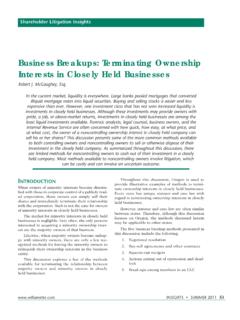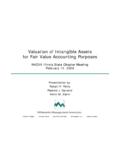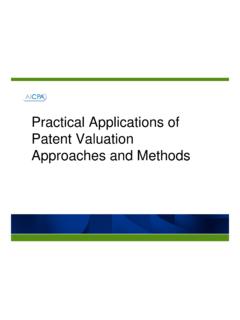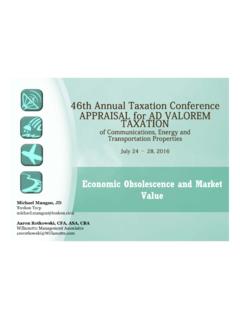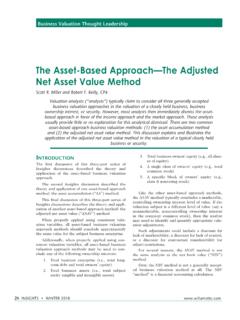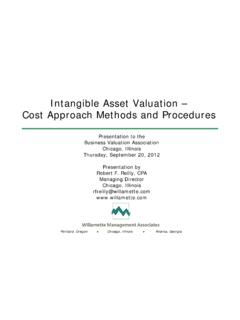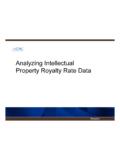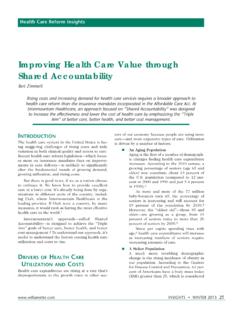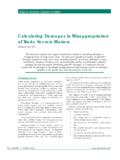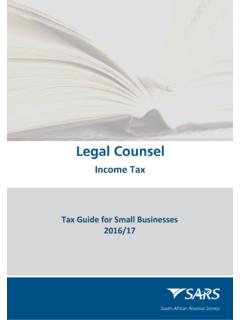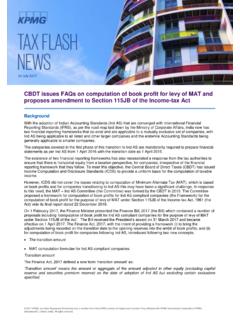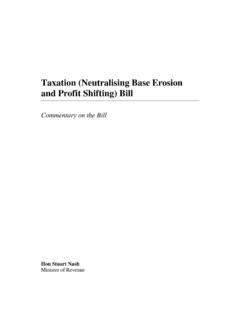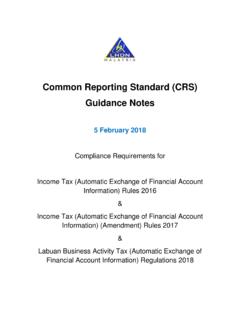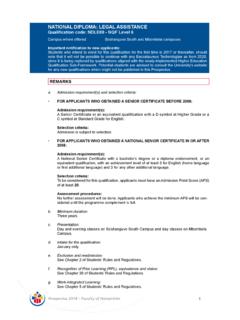Transcription of Determining the Discount for Lack of …
1 32 INSIGHTS WINTER 2017 www .willamette .cominTroducTionBusiness valuations prepared for gift and estate tax purposes usually involve the valuation of a privately held company, which are nonmarketable (or, at best, privately marketable).In these valuations, the valuation analyst (ana-lyst) typically estimates the value of the company first as if the underlying shares were publicly mar-ketable. Then, the analyst incorporates a Discount for lack of marketability (DLOM) to reflect the fact that the underlying shares are nonmarketable (or privately marketable).The Internal Revenue Service (the Service ) has issued long-anticipated proposed regulations under Internal Revenue Code Section 2704 that attempt to substantially reduce the application of valuation discounts to intrafamily transfers of inter-est in entities (such as corporations, partnerships, or limited liability companies).
2 1If initial interpretations prove correct, these regulations may restrict the DLOM to the value of a six-month put restriction stems largely from the creation of a new category of disregarded restrictions. Some commentators have viewed this new category of restrictions as effectively valuing transfers of interests in family-controlled entities as if the hold-er of the interest has a put right to sell the interest to the entity within six months for a value at least equal to a pro rata part of the net value of the entity in return for cash or discussion introduces and compares put option pricing models to estimate the DLOM for gift and estate tax Background of Section 2704 Section 2704 was enacted in 1990 with the goal of limiting discounts for certain family-owned, or closely held.
3 Interests that are transferred to family an individual and the individual s family hold voting or liquidation control over a corporation or partnership, Section 2704(a) provides, in general, that the lapse of a voting or liquidation right shall be taxed as a transfer subject to gift or estate an applicable restriction limits the ability of the corporation or partnership to liquidate, and that restriction can be removed by the family, then Section 2704(b) provides that the restriction is Valuation Practices and Procedures InsightsDetermining the Discount for lack of Marketability with Put Option Pricing Models in View of the Section 2704 Proposed RegulationsJohn E.
4 Elmore, JD, CPAP roposed regulations under Internal Revenue Code Section 2704 introduce the use of a six-month put option to estimate the Discount for lack of marketability of business ownership interests for gift, estate, and generation-skipping transfer tax transactions. This discussion outlines the various put option models often relied on by valuation analysts to estimate the Discount for lack of Practiceswww .willamette .com INSIGHTS WINTER 2017 33disregarded in valuing the transferred interest for gift or estate tax the existing regulations, an applica-ble restriction does not include any restriction imposed, or required to be imposed, by any Federal or State law (or commercially reasonable restric-tions imposed by unrelated persons in a financing transaction).
5 This provision has been interpreted by the Service to mean that default restrictions on the abil-ity of an owner to withdraw from a subject entity could be considered, even though the family could have overridden those restrictions in the governing states have a default rule limiting the abil-ity of a limited partner or member of a limited liabil-ity company to withdraw, and the Service stated that the default rule in the regulations has made Section 2704(b) substantially ineffective. 3 The proposed regulations eliminate this default rule by providing that applicable restrictions must be mandated by federal or state law (and thus not permitted to be overridden by the family) in order to be considered in Determining the fair market value of the transferred proposed regulations further limit the valu-ation discounts with the introduction of the disre-garded restrictions.
6 This new category of restrictions is defined as a provision of the governing documents or applicable law that limits the ability of the interest holder to compel liquidation or redemption of an interest on no more than six months notice for cash or prop-erty equal at least to what the proposed regulations call minimum value. 4 The regulations do not include specific examples of corporations or limited partnerships or limited liability companies that are merely silent on the ability of a shareholder, limited partner, or member to withdraw and have the interest redeemed by the subject generally have read into the pro-posed regulations a deemed put right. They note that the disregarded restrictions provision may have very little impact on valuation if it is not interpreted to value transferred interests as if a six-month put right at minimum value of the Put Option Pricing ModelsA put option, simply stated, is an option to sell financial assets at an agreed price on or before a particular date.
7 Put options are based on financial option pricing theory. This the-ory has been used to explain the purportedly irrational pricing that is observed in certain situ-ations in the capital markets, as conventional methods may understate the intrinsic value of a financial option pricing models (POPMs) have been applied to estimate the DLOM for private company interests. Despite some shortcomings, POPMs are still one of the few available techniques to actually quantify a stated that a lack of liquidity is a form of DLOM that exists when an interest holder cannot dispose of the interest quickly unless the holder is willing to accept a significant reduction in concluded that this lack of liquidity, and by extension the DLOM, can be estimated based on a POPM:One can also model the cost of the lack of liquidity as the value of a forgone put option.
8 However, the option formulation is more complex than in the case of the lack of marketability because there is no legal or contractual restriction on the holder s abil-ity to sell or transfer the asset, and, conse-quently, the length of the restriction period is less clear. For example, the market for an asset may be poorly developed, making it difficult, time-consuming, and therefore expensive to find a buyer for the securities, but the assets are nevertheless marketable. The restrictions are financial, rather than legal or contractual, and there is no fixed date on which they are scheduled to lapse. It takes more time to find a buyer in an illiquid market than in a liquid market.
9 This loss of flexibility to sell an asset freely or, equivalently, the ability to sell it quickly but only if there is some concession of intrinsic value, can be modeled as the loss of value of a put , an early pioneer in applying POPMs to estimate the DLOM, wrote that by purchasing a put option, a restricted stock ( , one that is exercisable only at the end of the option period) would reasonably replicate the lapsing of Securities and Exchange Commission (SEC) Rule 144 ,9 [L]ack of liquidity is a form of DLOM that exists when an interest holder cannot dispose of the interest quickly unless the holder is willing to accept a signifi-cant reduction in value.
10 34 INSIGHTS WINTER 2017 www .willamette .comIt is instructive, therefore, to view the results of the POPMs through the lens of restricted stock studies. Exhibits 1a and 1b present a summary of restricted stock studies categorized into three time periods related to changes in the holding period provision of SEC Rule restricted stock studies generally indicate a decrease in the average DLOM after 1990. The restricted stocks analyzed in the studies covering the 1968 to 1988 period (where the average indi-cated DLOM was approximately 35 percent) were generally less marketable than the restricted stocks analyzed after 1990 (where the average indicated DLOM was typically less than 25 percent).
